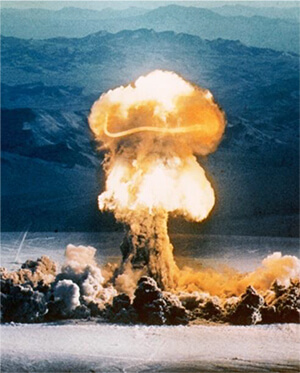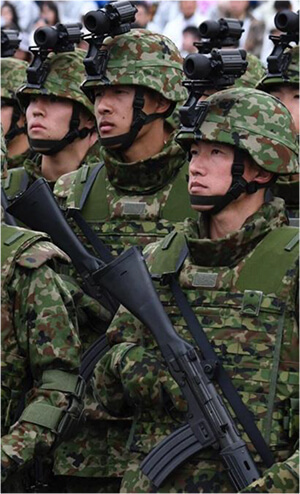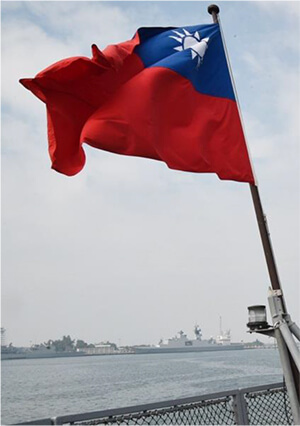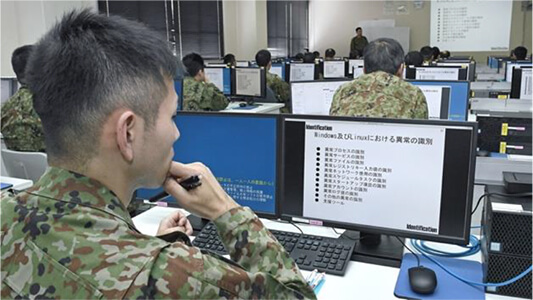



China’s assertive behaviour in the Indo Pacific region and the threat of Taiwan invasion is forcing Japan to discard its postwar pacifist policy and become a security player in the region. A new security framework is emerging and Japan is likely to play a role of an indispensable ally, which can put both a bold vision and robust contribution to regional security. This will inevitably put Japan at risk, in which the cyber realm will be the advanced guard. It is likely that the readiness of Japanese society to embrace its new role will be first tested precisely in the cyber realm and it is not yet clear that other sectors of the society besides the military are ready for the challenge.
Key points
After the staggering defeat in World War II, both Japan and Germany renounced militarism and relinquished some of their sovereignty, moving their defenses largely under the nuclear defense umbrella of the United States. This was formalized by the U.S.-Japan Security Treaty and West Germany’s membership in NATO. Both countries also underwent a huge cultural change as the generation that had lived through war and experienced the horrors and crushing defeat the military ambition to dominate the region brought their nation redirected its energies to rebuilding their countries and subsequently to rise to the top economically through commerce. Pacifism also developed very strong roots in both the countries, but this did not mean an absence of military capacity in Germany.
Unlike Japan, Germany had built an enormous land army during the Cold War because of the threat of Soviet invasion. The Soviet Union was a land power, focusing its energies on contest with the West. The prospect of its amphibious takeover in the Indo-Pacific was minimal, leaving Japan to develop its economy and keep relying on pacifist national ethos. Only at the end of the Cold War, Germany allowed its military to deteriorate to the point of dysfunction, free riding on the security guarantees posed by the NATO alliance.
The times however are changing. Faced with the Russian invasion of Ukraine, German society must now accept the harsh reality that large-scale military conflict remains a real possibility even today. In the face of this reality, German Chancellor Scholtz has promised a fundamental change in national policy, the so-called ‘Zeitenwende‘, however the German government is yet to deliver any substantial change in the defense posture of the country.
However, we can find a real ‘Zeitenwende‘ in defense policy, but to find it, we must look for in Japan. Japan is facing China’s expansionist policy in the Indo-Pacific and the threat of a Chinese invasion of Taiwan. The very real possibility of such an invasion is one of the preconditions for changing one of the central tenets of Japanese policy after World War II, slowly overturning the pacifist posturing of the country and remilitarizing its society to a degree considered standard in the NATO countries.
Japanese Prime Minister Fumio Kishida met with Joe Biden in January and subsequently announced Tokyo’s plan, to double defense spending from one to two percent of GDP. This decision has been compared to the German Zeitenwende, but in fact it goes far beyond it in significance and marks a real change in Japanese attitude.

During the Cold War, the United States and Japan focused on the threat posed by the Soviet Union and kept its limited military capabilities in the north of Japan. After the Cold War ended, Japan turned to face primarily the threat from North Korea in the east. As a result, China in the South was not a top priority until this decade, but with growing tensions caused by China’s huge military buildup and aggressive posturing in the Indo-Pacific, Tokyo now must increasingly focus on China and buildup of its own military capabilities as well as their deeper integration with the United States. This was a goal that longtime Prime Minister Shinzo Abe advocated, before his untimely death.
The Japanese are thus shifting more of their capabilities to their southwest islands, a critical geographic area, that at its closest point is just 100 miles off the coast of Taiwan. At the same time, over the past decade, both Japan and the United States have responded to the threat posed by ascendant China, by gradually strengthening military capabilities and building capacity in the area, with the goal of deterring potential conflict. However, the Russian invasion of Ukraine has reminded governments in Tokyo and Washington that deterrence can fail and the consequences can be disastrous in such a case. The increasing pressure, Xi Jinping’s China is putting on its neighbors and especially on Taiwan are another reason for concern.
Nobody knows for sure whether Xi Jinping is really willing to take such a huge risk and invade Taiwan, the foremost global source of semiconductors, which mainland China considers its rebel province. Respected analysts and military planners are coming to completely contradictory conclusions; on the one hand, that China is not ready to invade and that the leadership is aware that even in case of military success, the political costs wouldn’t be worth the risk and thus China is not going to invade. On the other hand, the invasion will take place within the next two years at the latest, since president Xi has invested too much of his political capital into taking of the island, which he considers a centerpiece of China’s intention to shake up the global order. However, the experience of Vladimir Putin in recent years suggests that it is very much possible that even Xi Jinping himself does not yet know the answer to this question.
At the same time, we cannot be sure that the United States would actually enter into an open conflict with China, over Taiwan. Despite Joe Biden’s repeated statements to the contrary and despite pressure from parts of the security community to change the policy, the US still officially maintains policy of strategic ambiguity that does not clearly declare whether the US would provide direct military assistance to Taiwan or not.

Japan’s future military plans, then, are key to deterring China. Japan is still the world’s third largest economy, despite its long-term stagnation, and its announced increase in spending will make it the third largest defense spender. This is not in itself a revolutionary rejection of the pacifism, enshrined in the constitution, but the evolution of Japanese security policy is systematically moving towards re-militarisation. While major elements of Abe’s transformation program remained unfinished at the time of his assassination last year, many of the limits, imposed by the pacifist postwar constitution, imposed by Japan’s history (and written by the Americans, during the occupation) are now being relaxed or modified, and the current version of the constitution is now being reinterpreted to give the government more room to maneuver.
Prime minister Abe has failed to repeal the key Article 9 of the constitution, which prohibits Japan from waging war as means of dispute settlement and having a wartime army, and repealing of the Article is still not on the agenda anytime soon. But its new reinterpretation allows Tokyo cooperative action in the face of an “existential threat”. The course of action now includes a so-called “counter-strike” capability. What the two terms mean has not been officially defined, and what would pass under them in practice is far from clear. At present, it is clear that Japan would use force to defend the uninhabited disputed Senkaku Islands near Taiwan from a Chinese attack, as these are considered Japanese sovereign territory. But would Japan cooperate with
the United States in defending Taiwan?
Much would probably depend on the exact scenario. The United States has a large force structure in the eastern Pacific, with a fighter squadron currently stationed at Kadena Air Base on Okinawa with an U.S. Marine Corps detachment nearby. This base also constitutes the closest U.S. forward base to Taiwan. A Chinese invasion of the island could begin with a preemptive strike against Okinawa or any U.S. naval forces in the immediate vicinity (e.g., in the Philippines), which would necessarily result in the death of a significant number of Americans and make U.S. involvement in the conflict much more likely. Since, it would also involve an attack on Japanese territory, there is a high probability that Tokyo would authorize the use of its territory in a subsequent retaliatory operation. This would bring Japan to war with China.

In another scenario, the Chinese would avoid a preemptive attack on U.S. forces in the area and on Japanese territory and simply move quickly to a direct attempt to seize Taiwan. The question then would be, whether such an invasion would be considered an “existential threat” to Japan and to what extent Japan would support a possible American response. This could range from allowing U.S. forces to use bases on Okinawa for a U.S. response, to an attack with anti-ship missiles by the Japanese Self-Defense Forces themselves, against landing craft, while the United States moved its own forces into the area. The Japanese themselves, however, are apparently still undecided about how they would decide in such a situation; while there is strong public support for an overall strengthening of the country’s defenses, support for active military involvement in the event of a Taiwan crisis that did not involve direct attacks on Japanese territory would be significantly smaller.
The Japanese Self-Defense Forces (as Japan’s military is called), like their German counterparts in the postwar decades, have not enjoyed high social status, and building real capabilities is a long term project, not to mention the problem of recruiting new soldiers. People are not flocking to the military anywhere in Europe or Asia and Japan. With its history, it is certainly no exception.
Japan’s Zeitenwende will therefore not take the form of a shock change, but unless there is a direct attack on Japanese territory, in a theoretical invasion of Taiwan, it will be a gradual transformation, lasting many years. Moreover, the change in Japan’s posture is not happening in a vacuum; the new form of the U.S.-Japan alliance will be realized with a much wider involvement of South Korea, Australia or the Philippines in defense alliances, in response to China’s assertive behavior in the region.
Thus, while Japan’s transition from pacifism to an alliance posture of deterring China from attacking Japan or Taiwan is by no means complete, there is no denying that it is now well underway. Moreover, changes in the security situation in Japan are loosening restrictions, long imposed on the arms industry. Thanks to the war in Ukraine, we are finding that Western states are currently unable to produce ammunition and weapons in sufficient quantities, thanks to the declining military industrial base, following the end of the Cold War and the migration of energy-intensive industries from Europe. This is currently being brilliantly exploited by South Korea, which has become a very significant arms exporter. Japan, however, has the industrial capacity and holds licenses to manufacture some U.S. weapons and could make a significant contribution to the broader defense efforts of the coalition of democracies against the emerging Beijing-Moscow-Pyongyang axis. Japan could thus also benefit economically from the change.

Japan’s strategic documents place a heavy emphasis on strengthening cyber capabilities across multiple lines of effort. Planned initiatives include creating a revamped national incident response center, with broader authorities to set cybersecurity standards across the Japanese government and to promote public-private information sharing on cyber threats to critical infrastructure. The documents call for developing an “active defense” cyber capability, in which the government would have the ability to penetrate and disrupt the computer networks of an adversary. Japan’s National Defense Strategy calls for a significant expansion of the Self-Defense Forces’ cyberforce, which should increase by more than a factory of 20 over the next five years.
The Defense Ministry’s plans are arguably ahead of the curve inside the government as well as the rest of the Japanese society. Other ministries, with a role in national security, may need to step up as well and the same goes for companies in strategic infrastructure, energy, finances or logistics. The overarching priority for the Japanese government and business should be to strengthen common network security standards and cybersecurity practices across the country. In this context, the stated plans to develop an “active defense” capability are a secondary priority, because from China’s behavior in the last years, we can presume that any hostile activity would start with a surprise cyber attack. A surprise cyber attack may not be meant to be a debilitating Pearl-Harbor-type event, but rather intended as a sharp jab to see if the adversary is actually serious about the geopolitical issue at stake. In a swift cyber raid, the primary effort might not be to resolve the military matter, but it could keep the victim reeling, when it should be reacting to other moves by the attacker.
The steps taken by the Japanese government, outlined above, appear to be just the beginning of a series of initiatives, intended to bolster deterrence, by enhancing U.S.-Japan posture and capabilities. The changes in defense posture, currently happening across the Indo-Pacific region are not limited to Japan, but also include the Philippines, Australia or South Korea and represent the biggest change in a generation. The Japanese military puts emphasis on the cyber angle of the upcoming competition with China, but despite the many announced reforms, which constitute notable progress, much remains to be done, especially in other parts of the Japanese government and business.
China’s more assertive behavior is forcing Japanese defense spending and Japan is on a trajectory to become an indispensable ally in the regional security framework, which can put both bold vision and robust contribution to regional security. Japan’s transition from pacifism to the role of regional protector is not yet complete, but there is now no denying it is well underway. The cyber realm will be the advanced guard of this sea of change and it is more than likely that the readiness of the Japanese society to embrace its new role will be first tested precisely in the cyber realm.
From External Threat Landscape Management (ETLM) perspective, in the year 2023, following are the issues, which could potentially boil up for Japan, from a geopolitical standpoint.
From cyber perspective, we could potentially observe an uptick in attacks towards Japan from China, instead of direct confrontation, as Japan allied with the US, and China having closer relations with Russia and North Korea. Based on the above-mentioned geopolitical situation, especially Japan coming in rescue of likeminded countries, whose economies are failing possibly due to the debt trap as part of China’s initiatives and expansionist role.
CYFIRMA, as part of its 2023 predictions, has already highlighted on the following and there could quite a possibility these could be observed this year from a cyber perspective.
Threat actors in collaboration with other nation groups and corporates will continue to carry out espionage and cyber-attacks against targeted organizations and countries. There is already an undeclared cyber-warfare between nations, ongoing for quite some time. This could lead to changing power equations in the world with many new partnerships mushrooming, based on geopolitical needs and wants.
State-sponsored threat actors will find more ways of collaborating across boundaries to further the political agenda of their state masters, and at times also justify their domestic authoritarian policies for wider adoption. E.g.: Chinese threat actors hiring North Korean groups as part of Hacker-as-a-Service (HaaS) model. Collaboration of Russian Groups and Chinese Groups under Ransomware-as-a-Service (RaaS) model.
Geopolitical tensions, commercial competition, and socio- economic differences will trigger kinetic cyberattacks, resulting in actual physical damage and loss of lives.